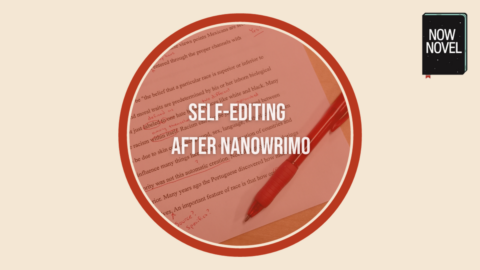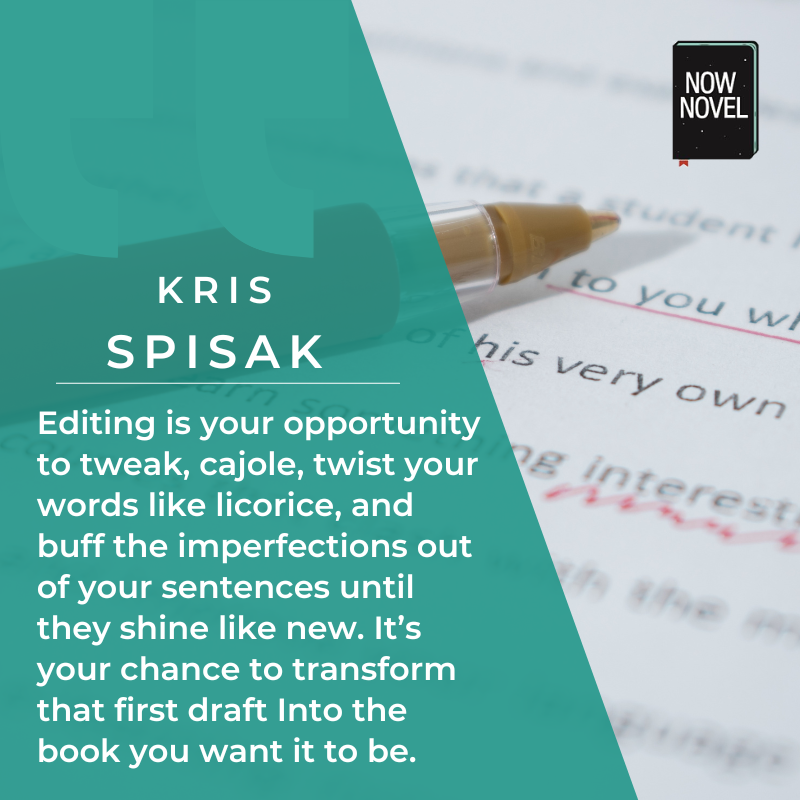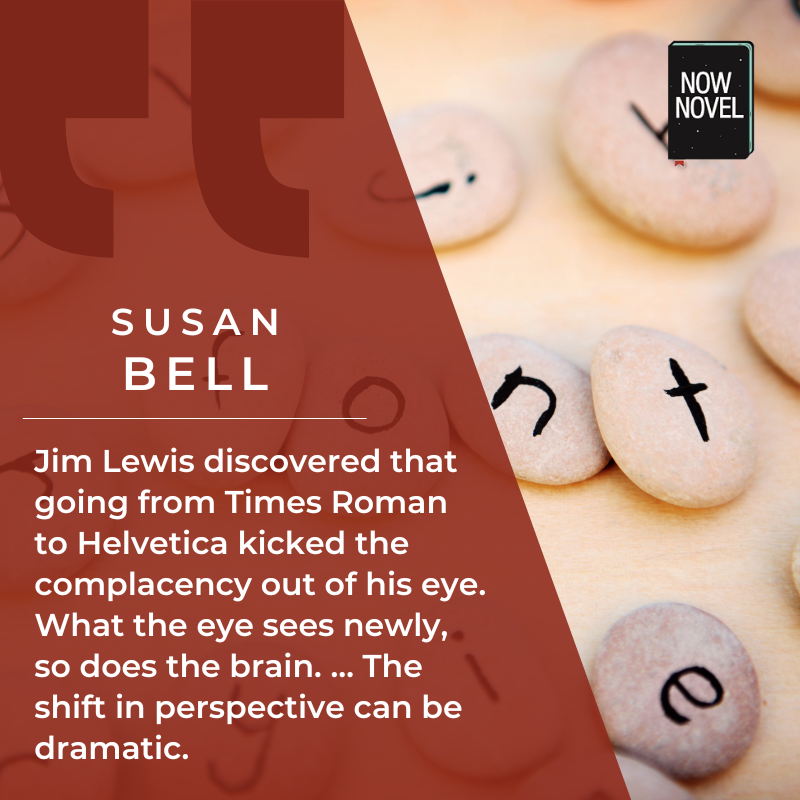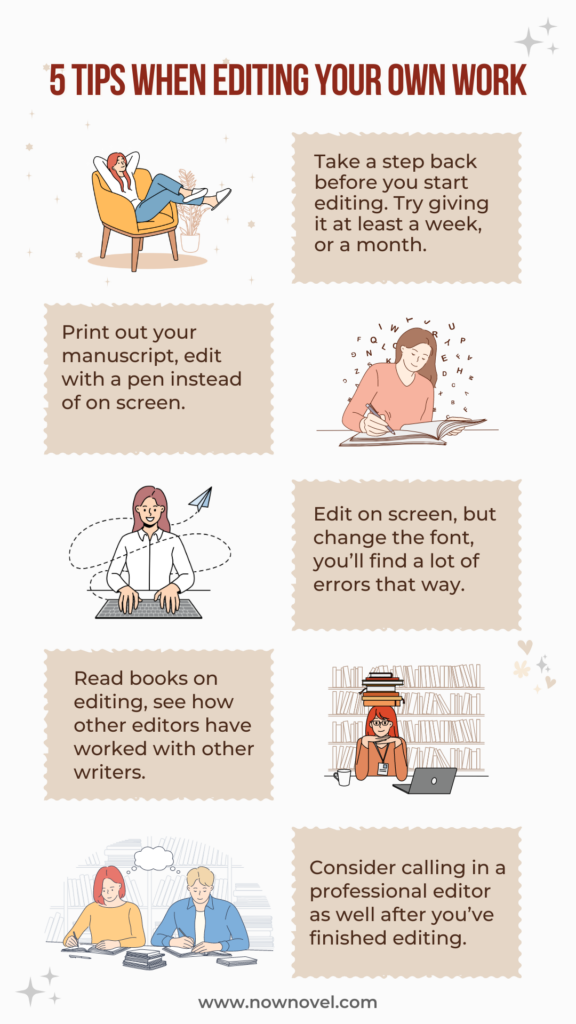Self-editing is a vital part of any writing process. Having completed a write-a-thon such as NaNoWriMo, you may have a shiny new manuscript on your hands if you’ve gone the distance. Now you need to start self-editing your manuscript. You might want to call in a professional editor at some point, but you still need to revise, edit and polish your work before sending to an editor, agent or publisher.
Editing your own work is essential. It can be daunting at first, but it’s a vital part of writing. It’s a chance to make your manuscript shine. Here’s what Kris Spisak, author of the excellent book, The Novel Writing Workbook, has to say about it:
Editing is a stage of the writing process that must be embraced. It’s your opportunity to tweak, cajole, twist your words like licorice, and buff the imperfections out of your sentences until they shine like new. It’s your chance to transform that first draft that trickled out of your fingers and onto the page, turning your story into the book you want it to be.
Read seven tips on how authors such as Margaret Atwood and Jefferey Eugenides edit their work.
Take a break
So, just how to twist your words like licorice? Where do you start?
Firstly, it’s a good idea to take a break from your manuscript. A little distance goes a long way. You’ll come back to your manuscript with a fresh eye and, importantly, less emotional investment in it. I don’t mean that you won’t care as passionately about your words as you should – and it’s important to keep that passion. I mean that you won’t come to your work fresh off that creativity high, that buzz you get when you type ‘The End’, and you know you’ve done it. In that space you often feel really close to the work you’ve just created, too close, and you’re not going to see (or want to see) its imperfections.
This applies to any sort of writing – from novels to short stories, poetry, essays and so on. My personal recommendation is to give it at least a month, but even a week or two will do the trick. A month may seem a longish time to leave a novel, for example, but it’s a good period to achieve that emotional distance.
The nitty gritty – macro and micro editing
So, coming back to your novel after that time, let’s look at how to edit.
If it’s a short work, like a short story, or an essay, you can choose to print it out and read it once for a fresh look at what you wrote.
Broadly speaking there are two types of edits. Macro editing or revision refers to taking a whole look at your manuscript. Take a look at what worked I your story, or didn’t, which characters ring true, or not, and make notes on your pages. Are there plot holes? Should you merge two characters? Is chapter one really chapter five? Is chapter one far too long and needs substantial cutting? Look for character inconsistencies, for example. Does your red-haired character have brown hair suddenly? This is where you will explore your story arc to see if it makes sense, or if any scenes are missing.
You can also do a close zoom in look at each scene, breaking each down, trimming dialogue and so on.
Editing your own work, especially if it’s a novel length manuscript, is essential. It can be daunting at first, but it’s a vital part of writing. It’s a chance to make your manuscript shine.
Tweet This
Copy-editing, or micro editing refers to line by line edits: grammar, spelling, punctuation and so on. Look for grammatical errors and highlight them as you go.
An interesting point is raised in this Scribe post where it is suggested that you edit for a twelve-year-old: in other words, make your language as clear and simple as possible.
If grammar (and spelling) isn’t your forte, make use of your word processing program to spot these errors. MS Word will underline incorrect spelling in red, and incorrect grammar in blue. Remember to set your proofing language, too. While the default is US spelling, you can change that, and can change it to make all new documents For a more finessed look at your grammar, Grammarly is an excellent program, as well as is ProWritingAid™. And then there’s the ever-evolving ChatGPT and other AI tools that can also check your grammar and spelling.
Take your time with the editing process, as editor Jennifer Kerslake explains. Kerslake says the editing process can take a while, and it too may take many drafts before you are happy with it.
Change the font or input handwritten MSs into a computer
You might not be comfortable with editing on the physical page, especially with a long work like a novel. In that case, use a different font, and edit that way. Here’s the reasoning from The Artful Edit: On the Practice of Editing Yourself by Susan Bell:
Type creates a famously useful distance between the writer and his words. But most contemporary writers are inured to type, having seen their manuscript take shape in it from the start. Non-handwriters need a new device to make their work look new.
Jim Lewis discovered that going from Times Roman to Helvetica kicked the complacency out of his eye. What the eye sees newly, so does the brain. … The shift in perspective can be dramatic.
If you do write by hand – and this is something to try as well – you will find the process of inputting your work into your computer is also a way of editing. Personally, I do all my writing on a computer, except for my journal writing as well my poems. While I still go through my poems on the page and tweak here and there, it’s in the inputting of my poems that most of the editing takes place.
Have a conversation, or give it to a friend
Another way of starting these vital edits also comes from The Artful Edit: On the Practice of Editing Yourself by Susan Bell. She suggests giving the manuscript to a fellow reader, perhaps another writer. You could offer to do the same for a writer friend. Bell recalls editing an essay by the art critic Neville Wakefield. She met up with him, and they discussed the manuscript, asking and answering questions. Once they were both satisfied Wakefield then typed up the version they had both discussed. Of this process, Bell says:
This kind of collaborative revision will not work for some writers who need to reflect at length and privately on their final version. But for many, conversation can be a marvelous tool for revision. It is especially helpful for magazine writers who face tight deadlines and have no time to step away from their draft.
Read books on editing
There are excellent books and guides to editing and it’s well worth reading up on how to edit before you tackle it yourself.
There are some perennial guides such The Elements of Style by William Strunk Jr. and E.B. White. This is an excellent resource on writing style and advice. It offers concise advice to help improve the clarity and precision of writing.
The Artful Edit: On the Practice of Editing Yourself by Susan Bell, is excellent too. And more than it makes for entertaining reading. If you feel editing is boring or a necessary evil, Bell’s enthusiasm for the topic might just change your mind. It’s also packed with stories of real life edits.
Kris Spisak’s The Novel Writing Workbook is a brilliant resource too. It is packed with great advice, as well as exercises in each chapter. Here’s a useful micro-editing one:
EXERCISE #49: Take a moment to consider the names of your characters. Do any of them sound similar? Could any of them be easily confused? Do many of them start with the same letter? Make sure you’re not setting up character names that are unnecessarily confusing for your readers.
Another recommendation is Revision and Self-Editing for Publication: Techniques for Transforming Your First Draft Into a Novel that Sells by James Scott Bell. A novelist himself, this covers everything from character development to story structure and provides practical tips for improving writing.
A professional editor
And, lastly, do consider hiring a professional editor before submitting your work to an agent or sending it to a publisher. You may have done your best, but it’s still important to have that ‘extra eye’, to hand it to a professional who also feels no emotional attachment to your writing. They will often find errors you may have missed, on a micro level, as well as on a macro level, and will often be able to spot plot holes, for instances, or see if a character is ‘weak’ or inconsistent. A detailed developmental edit is useful for catching all these problems.
You can find more information about a Now Novel edit here.




